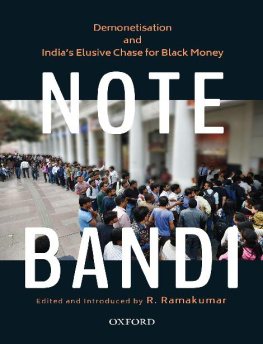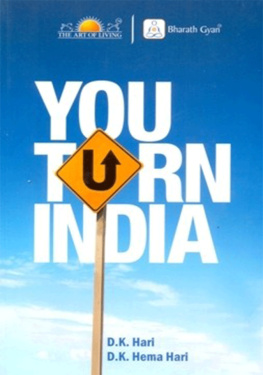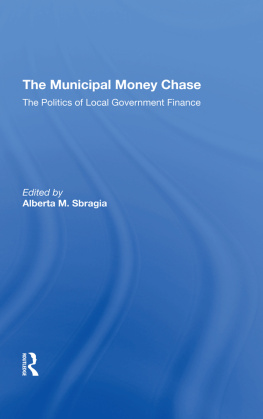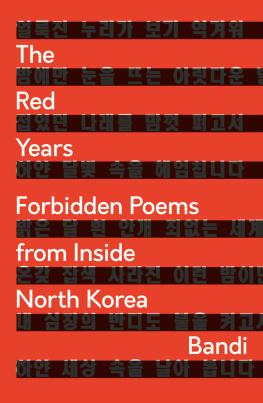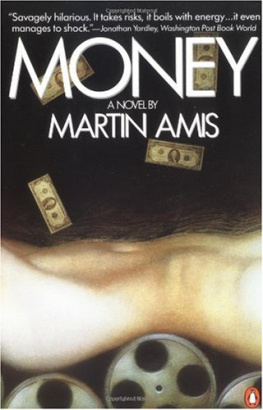NOTE-BANDI
NOTE-BANDI
Demonetisation
and
Indias Elusive Chase for Black Money
Edited and Introduced by
R. Ramakumar
With writings from the archives of the
Economic & Political Weekly
Oxford University Press is a department of the University of Oxford.
It furthers the Universitys objective of excellence in research, scholarship,
and education by publishing worldwide. Oxford is a registered trademark of
Oxford University Press in the UK and in certain other countries.
Published in India by Oxford University Press
2/11 Ground Floor, Ansari Road, Daryaganj, New Delhi 110 002, India
Oxford University Press 2018
Cover photograph: The demonetisation effect: Long queues at ATMs to withdraw cash
Ravi Choudhary/Hindustan Times via Getty Images
The moral rights of the authors have been asserted.
First Edition published in 2018
All rights reserved. No part of this publication may be reproduced, stored in
a retrieval system, or transmitted, in any form or by any means, without the
prior permission in writing of Oxford University Press, or as expressly permitted
by law, by licence, or under terms agreed with the appropriate reprographics
rights organization. Enquiries concerning reproduction outside the scope of the
above should be sent to the Rights Department, Oxford University Press, at the
address above.
You must not circulate this work in any other form
and you must impose this same condition on any acquirer.
ISBN-13 (print edition): 978-0-19-948679-3
ISBN-10 (print edition): 0-19-948679-4
ISBN-13 (eBook): 978-0-19-909272-7
ISBN-10 (eBook): 0-19-909272-9
Typeset in Adobe Garamond Pro 10.5/12.5
by The Graphics Solution, New Delhi 110 092
Printed in India by Replika Press Pvt. Ltd
Disclaimer: The views expressed in this volume are those of the volume
editor and authors and do not, in any way, reflect the publishers viewpoint.
Every effort has been made by the editor to contact the copyright holders, some
of whom could not be identified or located. The publisher hereby states that any
information brought to notice regarding these copyright holders will be acknowledged
in future reprints of the book.
Dedicated to the memory of Indian citizens who lost
their lives due to demonetisation
Contents
R. Ramakumar
Shankar Acharya
O.P. Chopra
Poonam Gupta and Sanjeev Gupta
J.C. Sandesara
Sacchidananda Mukherjee and R. Kavita Rao
Dev Kar
D. Ravi Kanth
S.S.S. Kumar
Paranjoy Guha Thakurta, Shinzani Jain and Advait Rao Palepu
I.S. Gulati
Gopinath Pradhan and M. Govinda Rao
Jagdeep S. Chhokar
J. Dennis Rajakumar and S.L. Shetty
Vineet Kohli and R. Ramakumar
Amitava Bandyopadhyay, Ranjan Sett and Dipak K. Manna
C.P. Chandrasekhar
Atul Sood and Ashapurna Baruah
Prabhat Patnaik
Parag Waknis
Ashok K. Lahiri
Ashok K. Nag
P. Sainath
Rahul M.
R. Mohan
R. Nagaraj
Ritika Mankar and Sumit Shekhar
Tables
Figures
Demonetisationthe withdrawal of legal tender status of notes of denomination Rs 500 and Rs 1,000announced by Indias Prime Minister Narendra Modi over a televised address on 8 November 2016 will go down in history as one of the most reactionary and illogical economic policies ever attempted in independent India. It crippled an economy that ran on cash and was plagued by a slowdown; it destroyed the livelihoods of millions of farmers, workers, traders, women and the elderly; and it violated the dignity and liberty of law-abiding citizens.
Yet, in a post-truth world, demonetisation also left public opinion in India deeply polarised. The language of the state had a deceptive appeal. In a society marked by abject poverty and inequality, and where everyday lives of citizens are marred by myriad forms of corruption, it came as no surprise that Modis misadventure was received as a decisive measure. Economists like me knew of the earlier demonetisation of 1978. But we also knew that it had failed to unearth any significant amount of black money. We were also aware of quack ideologues of the right-wing who demanded measures like demonetisation and the substitution of income tax with a blanket transactions tax. But we had also dismissed them as obscurantist drivel. Never did one imagine that one among these irrational ideas would actually find a place in economic policy. Of course, many aspects of neoliberal economics are intrinsically inverted on logic. But the demonetisation of 2016 beat them all.
At such a juncture, it becomes imperative of those who continue to have trust in reason to say, ever more loudly, that the emperor is naked. But then, one irrationality cannot be fought with another. The struggle against irrationality is also a battle for reason. Facts have to be marshalled; claims have to be broken down and analysed; and inferences have to be fed into an alternative discourse. This volume is an effort towards building up such an alternative, fact-based discourse on demonetisation.
In his address to the nation, the Prime Minister made two major claims in defence of demonetisation: on the one hand, it would stamp out counterfeit currency that was aiding terrorism; on the other, it would help the government unearth black money. Soon after the address, one also heard television commentators waxing eloquent on Indias imminent embrace of a cashless economy.
A day into demonetisation, I had an opportunity to write a response to these three claims. First, the claim that demonetisation would hit terror financing was overstretched because the total circulation of counterfeit currency did not exceed 0.002 per cent of the total notes in circulation. Second, no significant mobilisation of black money may be expected, as about 94 per cent of the unaccounted wealth was stored in the form of non-cash assets. Third, a cashless economy can never be created over diktats, as the persistence of cash was a structural feature of the economy. What India needed was a structural transformation of its informal economy into a modern and productive sphere, which would systemically reduce the dependence on cash. A war on cash would thus be ineffective and premature. Sycophants apart, these views were also shared by economists across the left-right spectrum.
As I write this preface almost a year later, I see no reason to revise my position. First, according to the Reserve Bank of Indias (RBI) Annual Report for 201617, the total value of counterfeit notes of denomination Rs 500 and Rs 1,000 detected by banks rose from Rs 27.4 crore in 201516 to Rs 40.8 crore in 201617: an increase by just about Rs 14 crore. As a share of the value of Rs 500 and Rs 1,000 notes in circulation in November 2016, the value of counterfeit notes detected in 2016-17 amounted to just 0.0027 per cent. The critics were right; the extent of circulation of counterfeit notes did not, in any way, justify a drastic action like demonetisation.
Second, the RBI also released estimates of the value of old notes returned to the banks between 10 November 2016 and 30 June 2017. Out of the Rs 15.44 lakh crore worth notes of Rs 500 and Rs 1,000 in circulation as on 8 November 2016, about Rs 15.28 lakh crore had returned to the banks. In other words, 98.96 per cent of the demonetised notes were back in the banks and only 1.04 per cent remained outside. Even this was not a final estimate; just on the previous day, i.e., 29 June 2017, the RBI had provided a one-month window for District Central Co-operative Banks (DCCBs) for remitting their remaining cash stock and exchanging for new notes. These did not form part of the estimate of old notes returned as on 30 June 2017. The return of about 99 per cent of the demonetised notes is the most important indicator of the failure of demonetisation. In December 2016, the Attorney-General of India, Mukul Rohatgi, had informed the Supreme Court that the government did not expect more than Rs 12 lakh crore to be back in the banks. The remaining Rs 3 lakh crore was black money, which would not return to the banks and could be extinguished and passed on by the RBI to the government as dividend. Red-faced, the government tried to contain the damage by claiming that demonetisation was intended to bring back all cash into the formal banking system. But in the public eye, the jury was no more out. There was no black money left to be extinguished.



